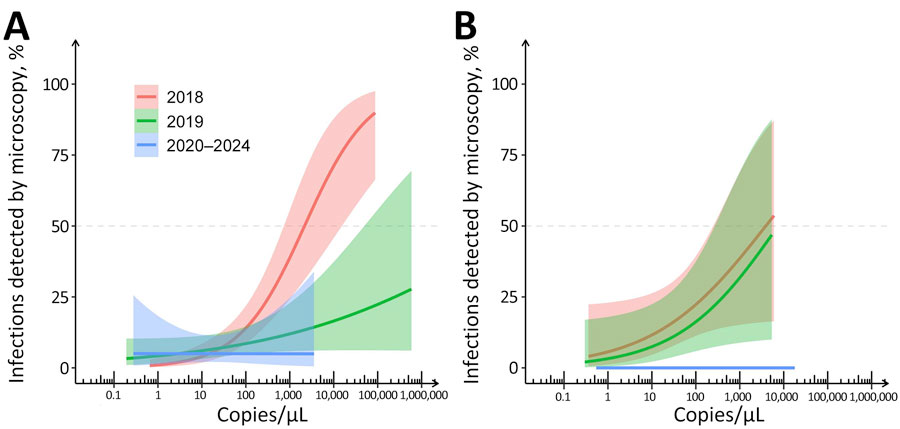Lower Microscopy Sensitivity with Decreasing Malaria Prevalence in the Urban Amazon Region, Brazil, 2018–2021
Priscila T. Rodrigues, Igor C. Johansen, Winni A. Ladeia, Fabiana D. Esquivel, Rodrigo M. Corder, Juliana Tonini, Priscila R. Calil, Anderson R.J. Fernandes, Pablo S. Fontoura, Carlos E. Cavasini, Joseph M. Vinetz, Marcia C. Castro, Marcelo U. Ferreira

, and
on behalf of the Mâncio Lima Cohort Study Working Group1
Author affiliations: Centro Nacional de Pesquisa em Energia e Materiais, Campinas, Brazil (P.T. Rodrigues); University of São Paulo, São Paulo, Brazil (P.T. Rodrigues, I.C. Johansen, W.A. Ladeia, F.D. Esquivel, R.M. Corder; J. Tonini, P.R. Calil, A.R.J. Fernandes, P.S. Fontoura, M.U. Ferreira); State University of Campinas, Campinas (I.C. Johansen); Universidade Federal do ABC, Santo André, Brazil (J. Tonini); Instituto Federal de Educação, Ciência e Tecnologia de Minas Gerais, Belo Horizonte, Brazil (A.R.J. Fernandes); Ministry of Health, Brasília, Brazil (P.S. Fontoura); Faculdade de Medicina de São José do Rio Preto, São José do Rio Preto, Brazil (C.E. Cavasini); Yale School of Medicine, New Haven, Connecticut, USA (J.M. Vinetz); Universidad Peruana Cayetano Heredia, Lima, Peru (J.M. Vinetz); Harvard T.H. Chan School of Public Health, Boston, Massachusetts, USA (M.C. Castro); Global Health and Tropical Medicine, NOVA University of Lisbon, Lisbon, Portugal (M.U. Ferreira); Institute of Hygiene and Tropical Medicine, NOVA University of Lisbon (M.U. Ferreira)
Main Article
Figure 3

Figure 3. Proportion of TaqMan-detected single-species Plasmodia vivax (A) and P. falciparum (B) infections that were detected by microscopy according to parasite density (amplicon copies per microliter measured by species-specific TaqMan assays) in study of microscopy sensitivity and decreased malaria prevalence in the urban Amazon Region, Brazil, January 2018–December 2021. Lines represents the fitted logistic model trends; the shaded area indicates 95% CI for waves 1 and 2 (2018; red), waves 3 and 4 (2019; green) and waves 5–7 (2020–2021; blue). For this analysis, data from waves 1 and 2 (2018), 3 and 4 (2019), and 5–7 (2020–2021) were combined to achieve balanced sample sizes for fitting logistic models. CI could not be properly estimated for P. falciparum infections in waves 5–7 because of the small sample size (Appendix Table 2). The dashed horizontal line indicates 50% microscopic detectability at a given parasite density threshold, which for P. vivax infections in 2018 corresponds to 2,088 (95% CI 734‒14,572) amplicon copies/μL.
Main Article
Page created: August 01, 2024
Page updated: August 20, 2024
Page reviewed: August 20, 2024
The conclusions, findings, and opinions expressed by authors contributing to this journal do not necessarily reflect the official position of the U.S. Department of Health and Human Services, the Public Health Service, the Centers for Disease Control and Prevention, or the authors' affiliated institutions. Use of trade names is for identification only and does not imply endorsement by any of the groups named above.
